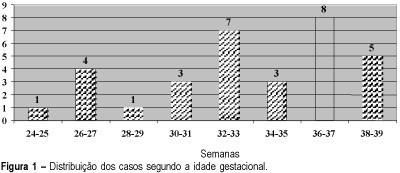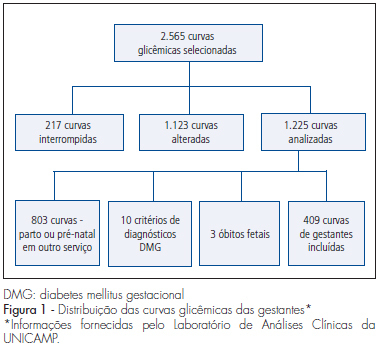You searched for:"Joao Luiz Pinto e Silva"
We found (22) results for your search.Summary
Rev Bras Ginecol Obstet. 2001;23(10):659-665
DOI 10.1590/S0100-72032001001000008
Purpose: evaluation of perinatal outcome of brain-sparing effect detected by color Doppler. Methods: brain-sparing effect was detected in 32 fetuses at the Ultrasound Service of the Center for Integral Attention to Women's Health at Campinas State University (UNICAMP). The diagnosis of brain-sparing effect was made when the ratio between middle cerebral artery and umbilical artery pulsatility indexes was below one (IPACM/IPAU <1). The measurement was obtained with color Doppler equipment Toshiba SSH-140A. Results: admission to neonatal intensive care unit (ICU) was necessary in 26 fetuses (89.6%). The number of days in ICU varied from 1 to 83 days, with a mean of 22 days. Fetal mortality rate was 3 in 32 (9.4%) and perinatal mortality was 9 in 29 (31%). Considering the gestational age by the Capurro method, the incidence of birth below 36 weeks was 21 in 32 (65.6%). Intrauterine growth restriction occurred in 71.8% of the cases and hypoglycemia in 44.8%. Conclusions: brain-sparing effect is a condition in which the fetus is at serious risk of adverse perinatal outcome and Doppler studies might be helpful in the obstetric management.

Summary
Rev Bras Ginecol Obstet. 1999;21(1):7-12
DOI 10.1590/S0100-72031999000100002
Purpose: to evaluate the accuracy of Doppler velocimetry in the diagnosis of fetal well-being. Methods: a total of 130 pregnant women assisted at the Ultrasound Unit of the Center for Integral Assistance of Women's Health, UNICAMP, between the 28th and 42nd gestational weeks was analyzed. The correlation between fetal umbilical and middle cerebral arteries, abdominal aorta, and the adverse perinatal results was established. The pregnant women selected for this study were submitted electively to cesarean sections, at the utmost four hours after the color Doppler examination. We considered as adverse perinatal results: Apgar score lower than seven at the 5th minute, neonatal intensive care unit hospitalization, intrauterine growth retardation, acute fetal distress, perinatal mortality, hypoglycemia, polycythemia, necrotizing enterocolitis, and cerebral hemorrhage. The indexes for the umbilical and middle cerebral arteries and the abdominal aorta were related, in each case, to the adverse perinatal results. Results: the systole/diastole umbilical artery ratio presented a higher sensitivity than the pulsatile and tolerance indexes. The Doppler study of the umbilical artery presented greater sensitivity than the middle cerebral artery and the abdominal aorta in detecting adverse perinatal results. Conclusion: the Doppler velocimetry of the umbilical and middle cerebral arteries presented good diagnostic capacity in evaluating fetal well-being, and a significant association with the adverse perinatal results.
Summary
Rev Bras Ginecol Obstet. 2005;27(12):759-767
DOI 10.1590/S0100-72032005001200009
PURPOSE: to carry out a literature review to evaluate the impact of assisted reproductive techniques (ART) on maternal and perinatal morbidity. METHODS: specialized data bases such as SCI and MEDLINE were used to identify studies related to the terms: "in vitro fertilization", "assisted reproduction" and "reproductive techniques" in combination with "morbidity", "maternal mortality", "perinatal mortality", and "neonatal mortality". RESULTS: data from published studies allow us to conclude that maternal morbidity is related to an increase in the number of multiple pregnancies. In addition, some studies have reported an increased incidence of pregnancy-induced hypertension and gestational diabetes. Specialized multidisciplinary prenatal care has been recommended to obtain optimal results. An increase in the number of multiple pregnancies considerably increases maternal, fetal and neonatal complications. There is also evidence of an increase in congenital malformations. The particular characteristics of this group of women and the different techniques of assisted reproduction, particularly ICSI, in the etiology of congenital defects were discussed, but no clear differences have been established between the various procedures. Some recent metanalyses show that the number of fetal malformations in infants born as a result of ICSI is greater than in spontaneously conceived infants, but not more frequent than in those born as a result of other ART. There is no consensus regarding whether this fact is a result of the procedure itself, of manipulation of the gametes, ovulation induction, if it is due to the fact that these couples are infertile or a result of the time they take to become pregnant. Few studies have carried out a prolonged, consistent and systematic evaluation of the perinatal evolution of infants born following the use of frozen embryos. CONCLUSIONS: with respect to fetal malformations, there is definitely a higher incidence rate among infants born as a result of ART compared to those conceived naturally (RR: 1.4-2.0; 95% CI: 1.3-2.7). Insufficient time and data do not yet permit analysis of the outcome of pregnancies resulting from the use of frozen embryos. It is not clear whether these findings are due to the characteristics of the couples who are submitted to these procedures or to the peculiarities of each method. Many of the problems related to maternal and perinatal morbidity are due to the significant number of multiple pregnancies originating from ART. More studies are required in order to clarify these aspects of human reproduction.
Summary
Rev Bras Ginecol Obstet. 2008;30(2):80-86
DOI 10.1590/S0100-72032008000200006
PURPOSE: to describe the clinical and laboratorial profile of HELLP syndrome patients admitted at an Obstetric Intensive Care Unit (ICU) and included in a randomized clinical trial to evaluate the efficacy of dexamethasone in this clinical setting. METHODS: the present study is a secondary analysis of a randomized clinical trial design to evaluate the efficacy of dexamethasone in patients with HELLP syndrome. This sample of patients was composed of patients in the puerperium, with the diagnosis of HELLP syndrome (diagnosis made before or after delivery) who were not chronic corticosteroid users and not carriers of any chronic disease which could modify HELLP syndrome's laboratorial parameters. Patients who were too critical or whose condition did not allow them to consent to participate were not included. Data were extracted from the records used in the randomized clinical trial. Age, parity, gestational age at admission and delivery, time of diagnosis (before or after delivery), HELLP syndrome classification (partial or complete), arterial blood pressure, and diuresis at admission were considered for analysis. Among laboratorial findings, hemoglobin, platelet count, liver enzymes, LDH, and serum bilirubin were analyzed. Complications presented by the patients were also analyzed as well as need of blood transfusions and duration of hospitalization. Analysis was made by the Epi-Info 3.3.2 program. RESULTS: one hundred and five patients were analyzed. Age varied from 14 to 49 years (means of 26.7). Regarding parity, 56 patients (53.8%) were primiparas. Analyzing the timing of the diagnosis, 47 patients (45.2%) had the diagnosis before delivery. The mean gestational age in these patients was 32.4 weeks. Hemorrhagic manifestations were observed in 36 patients (34.3%), oliguria was present in 49 patients (46.7%) and criteria for acute renal failure were seen in 21 (20%) of the cases. Hemotransfusions were necessary in 35 (33.3%) patients. Seven patients (6.7%) had pulmonary edema and four patients died, corresponding to 3.8% of the cases. The mean time from diagnosis of HELLP syndrome to discharge or death was 10.3 days, varying from 1 to 33 days. CONCLUSIONS: HELLP syndrome is an ominous diagnosis, which implicates in elevated maternal morbimortality. Among complications, oliguria and hemorrhagic manifestations were the most common findings and hemotransfusions were frequently required. Lethality reached 3.8%.

Summary
Rev Bras Ginecol Obstet. 2011;33(2):81-86
DOI 10.1590/S0100-72032011000200005
PURPOSE: to determine the prevalence of adverse gestational and neonatal outcomes in women with a positive screening and negative diagnosis for gestational diabetes mellitus (GDM). METHODS: a retrospective descriptive cross-sectional study was conducted from 2000 to 2009 on 409 women with positive screening for GDM. The maternal variables studied were: age, body mass index, history of cesarean section, macrosomia or diabetes mellitus in a previous pregnancy and a personal or family history of diabetes mellitus and chronic arterial hypertension. The neonatal variables studied were: polyhydramnios, gestational age at birth, prematurity, cesarean delivery, large for gestational age (LGA) newborn, macrosomia, Apgar score, neonatal respiratory distress syndrome, hypoglycemia and hyperbilirubinemia. Uni- and multivariate descriptive analyses were first performed regarding risk factors and neonatal outcome and the prevalences and respective 95% confidence intervals were determined. RESULTS: the route of delivery was cesarian section in 255 cases (62.3%), preterm birth occurred in 14.2% of cases and 19.3% of the newborns were LGA. The risk factors correlated with LGA newborns were overweight or obesity, maternal age and a history of macrosomia in a previous pregnancy. CONCLUSIONS: a high rate of LGA newborns was observed in the population with positive risk factors or altered fasting glycemia on the occasion of the first prenatal visit, even when the glycemia curve was normal, with cesarean rates above those habitually observed in populations considered to be of low risk. Pregnant women with these characteristics represent a differential group.

Summary
Rev Bras Ginecol Obstet. 1998;20(2):83-89
DOI 10.1590/S0100-72031998000200005
Results on investigation and immune treatment for recurrent abortion are presented. Up to 60% of patients who are free of any clinical identifiable cause for abortion are believed to have alloimmune abnormalities. One of the suggested therapies for this condition is paternal lymphocyte immunization. We present the result of 116 pregnancies followed at the Departamento de Tocoginecologia UNICAMP. Patients were thoroughly evaluated for causes of recurrent abortion mentioned in the literature (genetics, hormones, uterine abnormalities and infections), for autoimmune (antiphospholipid syndrome, abnormal autoantibodies) and for alloimmune causes (crossmatch by microlymphocytotoxicity and mixed lymphocyte culture). Patients who presented negative crossmatch and lower than 50% inhibition in mixed lymphocyte culture were treated with two concentrated intradermal paternal lymphocyte immunizations. Women were stimulated to attempt pregnancy with a positive crossmatch and higher than 50% inhibition in mixed lymphocyte culture. Women whose immune status did not change with this treatment were immunized again with paternal lymphocytes associated or not to a third party donor. We report that 81% of the women treated with this protocol had good pregnancy outcome.